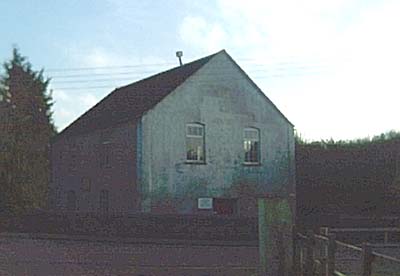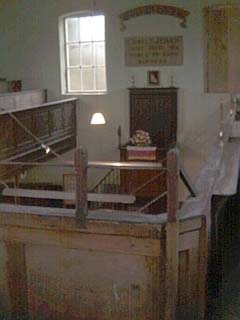 |
|

The church: Newport Independent Chapel, Newport, Gloucestershire, England.
Update:This report was published in 2002. In September 2006, the chapel, which has for some time been delapidated, finally closed.
Denomination: Independent (founded in the 17th century). Whilst Gloucestershire is mostly congregational, even after the URC merger, this chapel is still independent from even the Congregationalists, although related by association.
The building: A very quaint country chapel/meeting house of 1710-1825. It looks very dilapidated and is in an isolated lane outside the village. It is a large building with square sashed windows. The interior is a delight and is like stepping back in time! It has a huge pulpit with Victorian texts above it and a print with hands in prayer. There are late Georgian hat and coat pegs and three harmoniums and a Victorian stove. The pews were littered with huge old bibles and brass candlestick holders. Sadly, however, all dilapidated, with floor boards ripped up and a window blanked.
The church: It is the only church left in the village. The church was founded in the 17th century and met in barns before building the present meeting house in 1710. There are very few old established Independent churches left in England, although of course they abound in Wales. This particular chapel has no affiliation with any denomination and is completely independent in every way.
The neighbourhood: Newport is a straggling 18th century village on the A38, 15 miles from Gloucester. There is an air of neglect around the chapel as it is away from the village which used also to have an Anglican church which has long since gone. It is very rural and it looks as though things in this part of the countryside have not changed in over a century.
The cast: Chris Moody, visiting. The church invites ministers from other churches to speak to the congregation.
Sunday Worship.
How full was the building?
There were six people spread amongst the pews. The elderly lady at the back pew says she could remember when there was a choir of nearly 100 singing in the gallery at the back.
Did anyone welcome you personally?
There was silence as I walked in and everyone turned round. I introduced myself and was shown to a pew where the floor boards had not been dug up.
Was your pew comfortable?
Yes it was. A nice example of a tall, Georgian high-backed pew!
How would you describe the pre-service atmosphere?
It was quiet and reverential. You could just feel the history of the place around you and how a rural community must have loved it. The organist kicked off on what sounded like a Hammond organ, although I was told the harmonium worked quite well too.
What were the exact opening words of the service?
"Hello and welcome!"
What books did the congregation use during the service?
Everyone had a Bible and a Mission Praise Book II.
What musical instruments were played?
There were a host of instruments. In the old gallery where the choir used to sing was a flat harmonium – it was almost as if the choir had upped and gone. With congregations of six and 10 it takes a lot to imagine 100 people being in the gallery. There was a Gothic-looking harmonium down below which was once used for the main service, but these days the Hammond and the piano are used, as for this service.
Did anything distract you?
The weather outside was horrific given that it was Mothers' Day (which oddly enough didn't get a mention). I was distracted by being in a place which had clearly not changed for over 100 years and wondered what it was like in this rural chapel when all the pews were filled. I also thought it was sad that chapels like these are becoming a rare sight and a part of our heritage which will be gone if attendances are not improved.
Was the worship stiff-upper-lip, happy clappy, or what?
Oddly enough, a mixture of traditional chapel and modern. The feel of the service was in a totally reformed tradition and was like the chapel equivalent of the church in the Vicar of Dibley BBC TV series. There were traditional hymns and choruses.

Exactly how long was the sermon?
Roughly 40 minutes.
On a scale of 1-10, how good was the preacher?
8 – The preacher seemed very keen on his choruses as he asked us to choose a few.
In a nutshell, what was the sermon
about?
The sermon was based around Mark chapter 6 and was largely extemporary. The thrust was that Christians have compromised their faith by accepting Jesus along with the distractions of this world. He pointed out that the disciples questioned Jesus for not calming the storm and drew parallels with a family who had a disabled son, who had questioned how God could do such a thing. The preacher pointed out that it was not God but genetics. I felt uneasy about this as I could understand why the family had blamed God, even though I understood what the preacher was saying. However the preacher was lively and brought the place to life.
Which part of the service was like being in
heaven?
Being in a place with such a history!
And which part was like being in... er... the other place?
I had a chest infection and kept wanting to get a glass of water, but there was none to be seen. The lack of people made me sad for this place and I hope that as the only chapel in the village it might somehow get off the ground again.
What happened when you hung around after the service looking lost?
Had a chat with the people here who looked surprised to see a visitor in such a well-hidden place. I was told a little of the history and then took some photos. I told them a bit about my former church, St Thomas (Methodist) in Lampeter, and how from a congregation of six they grew to 60 and rebuilt their
dilapidated chapel. Maybe someone with vision and a feel for a challenge will take this chapel on.
How would you describe the after-service
coffee?
There wasn't any.
How would you feel about making this church your regular (where 10 = ecstatic, 0 = terminal)?
8 – I would love to be part of this church and to see it grow, but sadly I worship elsewhere. What the church here needs is to put itself on the map a bit maybe with notices, open days and the like and to take advantage of the fact that it is the only church in the village.
Did the service make you feel glad to be a
Christian?
Yes.
What one thing will you remember about all this in seven days' time?
Those late Georgian coat and hat pegs and the large texts on the wall above the pulpit.
| The Mystery Worshipper is sponsored by surefish.co.uk, the internet service provider from Christian Aid. By offering email services, special offers with companies such as amazon.co.uk and smile.co.uk, surefish raises more than £300,000 a year for Christian Aid's work around the world. Click here to find out how to become a Mystery Worshipper. And click here if you would like to reproduce this report in your church magazine or website. Top | Other Reports | Become a Mystery Worshipper! © Ship of Fools 2002 |